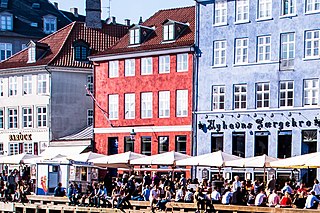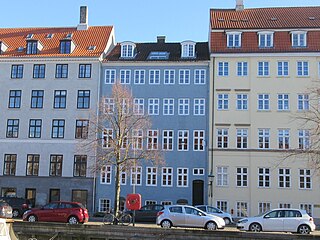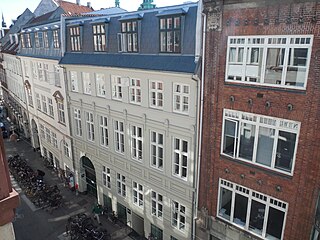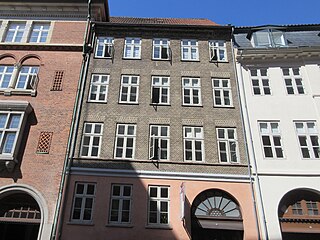
Nyhavn 33 is a listed property overlooking the Nyhavn canal in central Copenhagen, Denmark. A wall stone with a compass rose, a Dannebrog and two sand glasses bear testament to the fact that the building once belonged to a manufacturer of ship sails, flags and compasses.

Nyhavn 20, also known as the Boel House, is a listed property overlooking the Nyhavn canal in central Copenhagen, Denmark. A plaque on the facade commemorates that Hans Christian Andersen lived in the building when he had his first fairy tale published.

Nyhavn 63 is a historic townhouse overlooking the Nyhavn Canal in central Copenhagen, Denmark. The building was listed on the Danish Registry of Protected Buildings and Places in 1918. A warehouse in the courtyard has been converted into a hostel.

Nyhavn 27 is an 18th-century property overlooking the Nyhavn Canal in central Copenhagen, Denmark. The building was listed in the Danish registry of protected buildings and places in 1945. In the 18th century, it was for a while owned by the timber merchant Andreas Bodenhoff. The building was later operated as a hotel under the name Stadt Flensburg.

Snaregade 10 is a Neoclassical property located close to Gammel Strand in the Old Town of Copenhagen, Denmark. The book printing business J. D. Qvist & Co was from some time during the 19th century and until at least the 1950s based in the building. The football club KB was on 26 April 1876 founded in the apartment of one of the owners. The property was listed on the Danish registry of protected buildings and places in 1945. Its most characteristic feature is the inwardly curved facade of a former warehouse in the courtyard on its rear.

Lille Strandstræde 18 is a Neoclassical property situated off Sankt Annæ Plads in central Copenhagen, Denmark. It was listed in the Danish registry of protected buildings and places in 1950.

Brolæggerstræde 4 is a Neoclassical property situated in the Old Town of Copenhagen, Denmark. Like most of the other buildings in the area, it was constructed as part of the rebuilding of the city following the Copenhagen Fire of 1795. The three-winged complex was listed in the Danish registry of protected buildings and places in 1950.

Dronningens Tværgade 5 is a Neoclassical property situated in Dronningens Tværgade, opposite the Moltke Mansion, in central Copenhagen, Denmark. The building fronting the street, together with the adjacent buildings at No. 7 and No. 9, was constructed in 1793–1794 by master builders Hans Ondrup and A. Giedde. At the rear, there is a three-storey side wing and a one-storey former bank building, both dating from c. 1850. The entire complex was listed in the Danish registry of protected buildings and places in 1951 and 1999. Notable former residents include the jurist and later prime minister of Denmark Peter Georg Bang, the military officer Hans Dahlerup and the poet and author Vita Andersen.

Nyhavn 3 is an 18th-century property overlooking the Nyhavn Canal in central Copenhagen, Denmark. It was listed in the Danish registry of protected buildings and places in 1945.

Ovengaden Oven Vandet 52 is a mid 19th-century residential building overlooking Christianshavn Canal in the Christianshavn neighborhood of central Copenhagen, Denmark. The building was constructed in 1772 but heightened in 1846. It was listed in the Danish registry of protected buildings and places in 1945. Notable former residents include the botanist Erik Viborg, diplomat and politician Valdemar Rudolph von Raasløff and painter Edvard Weie.

Hauser Plads 12 is a Neoclassical property situated on the south side of Hauser Plads in the Old Town of Copenhagen, Denmark. It was listed in the Danish registry of protected buildings and places in 1945. Notable former residents include the actor Jørgen Christian Hansen and the film director Carl Theodor Dreyer.

Nyhavn 61 is an 18th-century residential building overlooking the Nyhavn canal in central Copenhagen, Denmark. The building was listed in the Danish registry of protected buildings and places in 1945. The scope of the heritage listing was expanded in 1984. Nyhavn 61 and Nyhavn 59 have now been merged into a single property and are physically integrated on the third floor. The two buildings share a central courtyard.

Nyhavn 21/Lille Strandstræde 4, formerly known as Hotel L'ven, Hotel Kronprinsen and Fredsfondens Hus, is a complex of historic buildings overlooking the Nyhavn canal in central Copenhagen, Denmark. It consists of a late 17th-century building in Nyhavn and a just two bays wide building in Lille Strandstræde as well as a two-storey rear wing from 1748. It was listed in the Danish registry of protected buildings and places in 1945. The restaurant Cap Horn was a popular jazz venue in the 1950s. It is now part of the Tholstrup restaurant group. Notable former residents include the politician Jens Christian Christensen and painters Anna and Michael Ancher.

Pilestræde 42 is an 18th-century building situated in Pilestræde in the Old Town of Copenhagen, Denmark. Originally a two-storey building from the 1730s, constructed on the foundations of Christian IV's Canon Foundry, it was later in the century heightened with two storeys. Pilestræde 42 and Pilestræde 44 were merged into a single property in the early 1970s. The two buildings were listed in the Danish registry of protected buildings and places in 1985.

Skindergade 22 is a Neoclassical building situated at the corner of Skindergade and Lille Kannikestræde in the Old Town of Copenhagen, Denmark. It was listed in the Danish registry of protected buildings and places in 1979. Jens Andersen Hansen, publisher of the newspaper Almuevennen and a member of the Danish Constituent Assembly, was a resident of the building in around 1849.

Gråbrødretorv 3 is an 18th-century townhouse situated on Gråbrødretorv in the Old Town of Copenhagen, Denmark. Together with the adjacent buildings Gråbrødretorv No. 1 and No. 5–9, it is one of the best examples of the so-called "fire houses" that were constructed throughout the city following the Copenhagen Fire of 1728. The building was listed on the Danish registry of protected buildings and places in 1926. It is a three-winged complex- consisting of a four-bay-wide, three-storey front wing and a four-bay-wide, three-storey rear wing, attached to each other via a staircase from 1816 along the east side of a central courtyard. A plaque on the facade commemorates that the poet Johan Herman Wessel (1742-1785) resided on the second floor when he wrote Jærlighed uden strømper in 1772. For the same reason, the building is also known as Wessel's House, although the poet never actually owned it but merely lived their as a lodger. Other notable former residents include the painter Nicolaus Wolff, master joiner Lasenius Kramp and art historian Harald Lundberg. In 1944, Langberg charged Elna Møller, a colleague from the National Museum of Denmark, with restoring the building.

Vestergade 7 is a Neoclassical building complex situated close to Gammeltorv in the Old Town of Copenhagen, Denmark. It was constructed for royal building inspector Andreas Kirkerup as part of the building of the city following the Copenhagen Fire of 1795. The property was listed on the Danish registry of protected buildings and places in 1991. Notable former residents include the master builder Johan Boye Junge and archeologist Peter Oluf Brøndsted. The Danish Institute for Study Abroad (DIA) is now based in the building. The adjacent building at Vestergade 5 is also owned by the Danish Institute for Study Abroad.

The Kanneworff House, situated at the acute-angled corner of Bredgade and Store Strandstræde, next to Nyhavn, is the smallest and oldest building on Kongens Nytorv in central Copenhagen, Denmark. The modest dimensions and unassuming design bear testament to the fact that its construction in fact predates that of the square on which it is now located.The building was listed on the Danish registry of protected buildings and places in 1918. It takes its name after Lars Kanneworff, a retailer of gentlemen's clothing who bought it in 1836, in the hands of whose family it remained for almost a hundred years. Copenhagen Amber Museum is now located in the building.

Nyhavn 22 is an 18th-century building overlooking the Nyhavn Canal in central Copenhagen, Denmark. In 1949, it was acquired by neighboring Hotel Bethel and used for an extension of the hotel. In the mid-19th century, it was owned by the businessman Mathias Wilheæl Saas. Other notable former residents include the medical doctor C.E. Fenger and painter Johan Rohde.

Nørregade 27 is a Neoclassical building situated on Nørregade in central Copenhagen, Denmark. It was constructed for a master tanner in the 1830s after the previous building on the site had been destroyed in the British bombardment of Copenhagen in 1807. In 1907, it was acquired by KTAS and merged with the adjacent Telephone House. In 1931, Nørregade 29 was also acquired by KTAS and merged with the complex. Nørregade 27 and Nørregade 29 were both listed in the Danish registry of protected buildings and places in 1939.
























